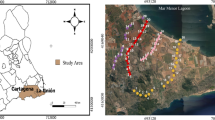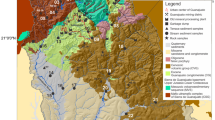Abstract
The concentration of major and trace elements have been determined in sediments samples taken from a mining dam, located in the upper area of the Tinto River basin (SW Spain). This dam, built to fulfil water needs for mining operations, is now completed clogged by accumulation of fine sediments. The results obtained for vertical and horizontal distribution of chemical elements showed highest average concentrations of Fe and Al, both with 10 %, and S (about 4 %). Toxic elements, such as As and Pb occur also with high concentrations (2515 and 5172 mg/kg, respectively). Determination of Enrichment Factors (EF) showed that sediments are enriched in elements related with the massive sulphide ore bodies and subsequent acid mine drainage processes. The elements Pb and As are that of major environmental concern, with enrichment factors higher than 10. Application of cluster analysis put in evidence the main sources of elements, allowing for the modelling of the origin of the accumulated matter. Therefore, in addition to contributions from sulphide (Fe, S) and gangue (Al, Mg), there are grouping of elements mobilized from phyllosilicates and feldspars, (e.g. Ca and K) as well as a specific group that reflects the geochemical affinity of rare earth elements in such acidic environment. Moreover, the way how elements are grouped testify the heterogeneity of geological contributions as well as the mining cycles over 4000 years of mining history in this worldwide known river basin.






Similar content being viewed by others
References
Ackermann F (1980) A procedure for correcting grain-size effect in heavy metal analysis of estuarine and sediments. Environ Technol Lett 1:518–527
Amils R, González-Toril E, Fernández-Remolar D, Gómez F, Agillera A, Rodríguez N, Malki M, García-Moyano A, Fairén A, de la Fuente V, Sanz J (2007) Extreme environments as Mars terrestrial analogues: The Rio Tinto case. Planet Space Sci 55:370–381
Banks D (2004) Geochemical processes controlling minewater pollution. Groundwater management in mining areas. Proceedings of the 2nd IMAGE-TRAIN Advanced Study Course. Prokop, Younger and Roehl Eds. Viena. 17–44
Borrego J, Ruiz F, González-Regalado ML, Pendón JG, Morales JA (1999) The Holocene transgression into the estuarine basin of the Odiel River Mouth (Cadiz Gulf, SW Spain): lithology and faunal assemblages. Quatern Sci Rev 18:769–788
Borrego J, Carro B, López-González N, de la Rosa J, Grande JA, Gómez T, de la Torre ML (2011) Effect of acid mine drainage on dissolved rare earth elements geochemistry along a fluvial-estuarine systems: the Tinto-Odiel estuary (SW Spain). Hydrol Res. doi:10.216/nh.2011.012
Buckby T, Black S, Coleman ML, Hodson ME (2003) Fe-sulfate-rich evaporative mineral precipitates from the Rio Tinto, southwest Spain. Mineral Mag 67:263–278
Carro B, Borrego J, López-gonzález N, Grande JA, Gómez T, de la Torre ML, Valente T (2011) Impact of Acid Mine Drainage on the hydrogeochemical characteristics of the Tinto-Odiel Estuary (SW Spain). J Iber Geol 37:87–96. doi:10.5209/rev_JIGE.2011.v37.n1.6
Chatterjee M, Silva Filho EV, Sarkar SK, Sella SM, Bhattacharya A, Satpathy KK, Prasad MVR, Chakraborty S, Bhattacharya BD (2007) Distribution and possible source of trace elements in the sediment cores of a tropical macrotidal estuary and their ecotoxicological significance. Environ Int 33(3):346–356
Chester R (2000) Marine Geochemistry. Cambridge University Press, Cambridge, p 506
Davis RA Jr, Welty AT, Borrego J, Morales JA, Pendón JG, Ryan JG (2000) Rio Tinto estuary (Spain): 5000 years of pollution. Environ Geol 39:1107–1116
de la Torre ML, Grande JA, Graiño J, Gómez T, Cerón JC (2011) Characterization of AMD pollution in the river Tinto (SW Spain). Geochemical comparison between generating source and receiving environment. Water Air Soil Pollut 216:3–19
Delgado J, Pérez-López R, Galván L, Nieto J, Boski T (2012) Enrichment of rare earth elements as environmental tracers of contamination by acid mine drainage in salt marshes: a new perspective. Mar Pollut Bull 64:1799–1808
Elbaz-Poulichet F, Dupuy C (1999) Behaviour of rare earth elements at the freshwater-seawater interface of two acid mine rivers: the Tinto and Odiel (Andalucia, Spain). Appl Geochem 14:1063–1072
Fernández JP, Grande JA, De la Torre ML, Valente T (2013) Contribution of GPR and magnetic methods to the definition of the internal structure of a clogged mining dam in the Riotinto Mine SW Spain. In: Water Resources Forest, Oc. & Marine ecosystem, pp 735–742. doi:10.5593/sgem2013
Galván L, Olías M, Cerón JC, Cánovas CR, Pérez-López R, Nieto JM (2013) Assessment of the dissolved pollutant flux of the Odiel River (SW Spain) during a wet period. Sci Total Environ 463–464:572–580
Grande JA (2011) Impact of AMD processes on the public water supply: Hydrochemical variations and application of a classification model to a river in the Iberian Pyritic Belt. S.W. Spain. Hydrol Res 42(6):472–478
Grande JA, de la Torre ML, Cerón JC, Beltrán R, Gómez T (2010) Overall hydrochemical characterization of the Iberian Pyrite Belt. Main acid mine drainage-generating sources (Huelva, SW Spain). J Hydrol 390:123–130
Grande JA, de la Torre LL, Santisteban M, Valente T, Fernandez P, Pérez-Ostalé E (2014) Spatial evolution of an AMD stream in the Iberian Pyrite Belt: process characterization and control factors on the hydrochemistry. Hydrol Sci J. doi:10.1080/02626667.2014.983515
Hwang HM, Green P, Young T (2009) Historical trends of trace metals in a sediment core from a contaminated tidal salt marsh in San Francisco Bay. Environ Geochem Health 31(4):421–430
Inverno C, Xavier Matos J, Rosa C, Castelo-Branco JM, Granado I, Carvalho J, Baptista MJ, Represas P, Pereira Z, Oliveira T, Araújo V (2013) Massive sulfide exploration models of the Iberian Pyrite Belt Neves Corvo mine region, based in a 3D geological, geophysical and geochemical ProMine study. Geophysical Research Abstracts Vol. 15, EGU2013-13350-2
Julivert M, Fontbote JM, Ribeiro A, Conde LE (1974) Mapa Tectónico de la Península Ibérica y Baleares. E: 1/1.000.000. IGME
Lanesky DE, Logan BW, Brown RG, Hine AC (1979) A new approach to portable vibracoring underwater and on land. J Sediment Petrol 39:655–657
Leblanc M, Morales JM, Borrego J, Elbaz-Poulichet F (2000) 4.500 year-old mining pollution in Southwestern Spain: Long-term implications for modern mining pollution. Econ Geol 95:655–662
Leistel JM, Marcoux E, Thiéblemont D, Quesada C, Sánchez A, Almodóvar GR, Pascual E, Sáez R (1998) The volcanic-hosted massive sulphide deposits of the Iberian Pyrite Belt Review and preface to the Thematic Issue. Miner Deposita 33:2–30
Loring DH (1991) Normalization of heavy-metal data from estuarine and coastal sediments. ICES J Mar Sci 48:101–115
Nácete F, Álex E, Nieto JM, Sáez R, Bayona MR (2005) An archaeological approach to regional environmental pollution in the South-Western Iberian Peninsula related to Third Millennium BC mining and metallurgy. J Archaeol Sci 32:1566–1576
Nieto J, Sarmineto A, Olias M, Avora C (2013) Acid mine drainage in the Iberian Pyrite Belt: 1. Hydrochemical characteristics and pollutant load of the Tinto and Odiel rivers. Environ Sci Pollut Res 20:7509–7519
Nordstrom DK, Alpers CN (1999) Geochemistry of acid mine waters. In: Plumlee GS, Logson MJ (eds). The environmental geochemistry of mineral deposits. Reviews in Economic Geology, vol. 6A, Society of Economic Geoligst. Inc, Littleton, 133–160
Olías M, Nieto JM, Sarmiento AM, Cerón JC, Cánovas CR (2004) Seasonal water quality variations in a river affected by acid mine drainage: The Odiel River (South West Spain). Sci Total Environ 333:267–281
Ridgway J, Shimmield G (2002) Estuaries as repositories of historical contamination and their impact on shelf seas. Estuar Coast Shelf Sci 55:903–928
Ruiz F, González-Regalado ML, Borrego J, Morales JA, Pendón JG, Muñoz JM (1998) Stratigraphic sequence, elemental concentrations and heavy metal pollution in Holocene sediments from the Tinto-Odiel estuary, south-western Spain. Environ Geol 34:270–278
Sáez R, Pascual E, Toscano M, Almodóvar GR (1999) The Iberian type of volcanosedimentary massive sulphide deposits. Miner Deposita 34:549–570
Sáez R, Moreno C, González F, Almodóvar GR (2011) Black shales and massive sulfides: causal or casual relationships? Insights from Rammelsberg, Tharsis, and Draa Sfar. Miner Deposita 46:585–614
Sáinz A, Grande JA, de la Torre ML (2003) Odiel river, acid mine drainage and current characterisation by means of univariate analysis. Environ Int 29:51–59
Salomons W, Förstner U (1984) Metals in the hydrocycle. Springer-Verlag, New York
Sánchez-España J, Velasco F, Yusta Y (2000) Hydrothermal alteration of felsic volcanic rocks associated with massive sulphide deposition in the northern Iberian Pyrite Belt (SW Spain). Appl Geochem 15:1265–1290
Sánchez-España J, López Pamo E, Santofimia P, Ercilla MD (2008) The acidic mine pit lakes of the Iberian pyrite belt: An approach to their physical limnology and hydrogeochemistry. Appl Geochem 23:1260–1287
Santisteban M, Grande JA, De la Torre ML, Valente T, Cerón JC (2013) Adid mine drainage in semi-arid regions: the extent of the problem in the waters of reservoirs in the Iberian Pyrite Belt (SW, Spain). Hydrol Res. doi:10.2166/nh.2013.086
Santofimia E, González-Toril E, López-Pamo E, Gomariz M, Amils R, Aguilera A (2013) Microbial diversity and its relationship to physicochemical characteristics of the water in two extreme acidic pit lakes from the Iberian pyrite belt (SW Spain). PLoS One 8(6):e66746 (Epub 2013 Jun 26)
Shua WS, Yeb ZH, Lana CY, Zhanga ZQ, Wongb MH (2001) Acidification of lead/zinc mine tailings and its effect on heavy metal mobility. Environ Int 26:389–394
Shumilin EN, Carriquiry JD, Camacho-Ibar VF, Sapozhnikov D, Kalmykov S, Sánchez A, Aguiñiga-García S, Sapozhnikov YA (2002) Spatial and vertical distributions of elements in sediments of the Colorado River delta and Upper Gulf of California. Mar Chem 79:113–131
Stecko JRP, Bendell-Young LI (2000) Contrasting the geochemistry of suspended particulate matter and deposited sediments within an estuary. Appl Geochem 15:753–775
Tornos F (2006) Environment of formation and styles of volcanogenic massive sulfides: the Iberian Pyrite Belt. Ore Geol Rev 28:259–307
Valente T, Almeida S, Rivera MJ, Delgado C, Gomes P, de la Torre ML, Santisteban M, Grande JA (2013) Relation between diatom communities and the degree of AMD affection in selected water dams in Iberian Pyrite Belt. Mineral Mag. doi:10.1180/minmag.2013.077.5.22
Valente T, Grande JA, De la Torre ML, Santisteban M, Cerón JC (2014) Mineralogy and environmental relevance of AMD-precipitates from the Tharsis mines, Iberian Pyrite Belt (SW, Spain). Appl Geochem 39:11–25
Younger PL, Banwart SA, Hedin RS (2002) Mine water: hydrology, pollution, remediation. Kluwer Academic Publishers, Dordrecht
Acknowledgments
This study is a contribution of the DGCICYT-CGL2010-21268-C02-01 project, which has been financed by the Spanish Ministry of Education and Science, and the Andalusian Autonomous Government Excellence Projects, P10-RNM-6570 project. The Institute of Earth Sciences (ICT) is funding under contract with FCT (the Portuguese Science and Technology Foundation, Reference UID/GEO/04683/2013. The authors greatly appreciate the efforts of the three anonymous reviewers who carefully review the paper, and their valuable suggestions to improve the manuscript.
Author information
Authors and Affiliations
Corresponding author
Rights and permissions
About this article
Cite this article
Valente, T., Grande, J.A., Cerón, J.C. et al. Spatial distribution of major and trace elements in a mining dam: sources and relationships among elements of environmental concern. Environ Earth Sci 75, 342 (2016). https://doi.org/10.1007/s12665-015-4863-z
Received:
Accepted:
Published:
DOI: https://doi.org/10.1007/s12665-015-4863-z




